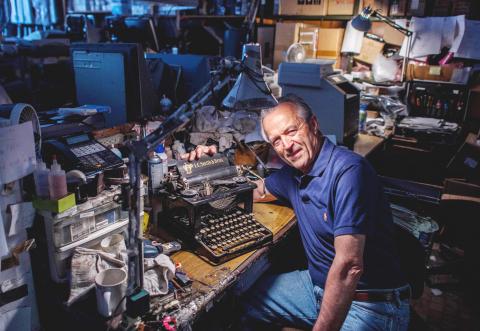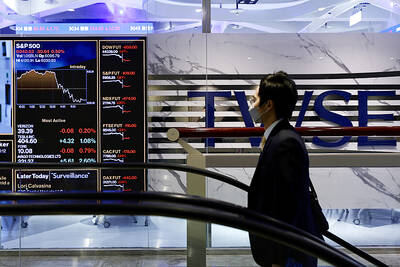Ermanno Marzorati has rarely been so busy. He is currently fixing a 1930 Underwood typewriter for Tom Hanks. However, there are plenty more ancient writing machines awaiting his tender care.
While the modern world taps away in an ever-increasing frenzy online, the Italian senses a new trend, from his calm Beverly Hills studio in California: the return of the art of slow writing.
Marzorati has restored typewriters belonging to Ian Fleming, Tennessee Williams, Jack London, Ray Bradbury, Ernest Hemingway and Orson Welles, as well as celebrities like Julie Andrews, Greta Garbo and John Lennon.

Photo: AFP
He proudly shows photographs of some of his best work, including an orange-colored Underwood machine dating from 1926, on which Orson Welles wrote Citizen Kane. It was totally destroyed when he got it.
“To me the typewriter is better than the computer, not because I’m old-fashioned, but because it slows you down. You have to choose the words carefully because you cannot correct,” he said. “It takes a long time to press the key.”
Collector Steve Soboroff says typewriters, unlike computer keyboards, have an intimate relationship with their owners.
“I just love the idea of authors, famous people, would spend hours of their lives on these typewriters, so they are very personal. And there’s only one of them, is not like there are hundreds of them,” he said.
“There’s only one for each,” added the biggest customer of Marzorati, whose studio is full of old printing machines, typewriters and mechanical calculators.
Occasionally Hanks tweets photographs of the vintage typewriters that Marzorati restored in his own collection.
Marzorati has a shelf dedicated to his most famous client, and he currently holds 12 machines belonging to the Forrest Gump star.
In all, the talkative Italian has about 60 machines waiting to be fixed — an enormous number compared with a few years ago. “I’m booked up for six months,” said the 68-year-old, who started repairing typewriters in 2003.
“Collectors are the exception. Most of the people I fix typewriters for are people who are going to use it,” said Marzorati, who was born in Italy in 1945 and moved to Los Angeles in 1969.
“I feel people, honestly, are getting fed up because all these iPhones, all these electronics, they like to get back to the basics,” he said.
However, the obvious question is, why would someone in the 21st century want to type on a heavy and difficult-to-use mechanical device, without the possibility of cutting, pasting, erasing or copying?
Marzorati said the advantages of computers are overrated.
“Writing on a computer is very distracting, because you get e-mail coming in, you type a word, you delete it, you change it, you get stuck,” he said.
His view is echoed by Christopher Lockett, who regularly takes his 1950 Hermes Baby typewriter with him to write in the open air in LA’s Griffith Park, next to the hipster Los Feliz district.
“There are no text windows in blue popping up, you can’t play music on it,” he said. “I shut off my iPhone, I take my typewriter and sit and I don’t worry about the typos, I keep moving forward, and I go dah dah dah dah ding!”
He compares the experience of using a typewriter to riding a bicycle.
“It’s an alternative to the most efficient way of doing something, it’s about enjoying the ride, and nobody gets angry about the notion of a bicycle. But people are like ‘typewriters are impractical,’” he said. “Well, so is a bicycle and people are still making bicycles and it’s not an issue.”
Lockett, a cameraman and documentary-maker, made a film on the subject last year called The Typewriter in the 21st Century, which is currently showing on the independent movie circuit in Los Angeles.
“I thought: ‘If the typewriter is going away, and is in part responsible for every great novel from the 20th century, they deserve a proper send-off,’” he said.
When he set about making the film he was surprised to find that, not only are typewriters not disappearing, but there is a surge of demand for old machines to be repaired and brought back to life.
“Suddenly typewriters were all over the Internet,” he said.
Artist Tim Youd is staging a performance in New York this month in which he taps out a Henry Miller novel on the same model of typewriter used by the writer.
Painter Louise Marler last year held a type-in event in Venice Beach. Young inventor Jack Zylkin meanwhile has created a “hack” that allows a mechanical typewriter to be connected to an iPad via a USB port.
Lockett said the wave of interest in typewriters should not be misunderstood as a desire to return to the past, and abandon modern technology.
“Nobody in the film is saying it is the only way to work. They’re making a case about something everyone is throwing away,” he said.

SELL-OFF: Investors expect tariff-driven volatility as the local boarse reopens today, while analysts say government support and solid fundamentals would steady sentiment Local investors are bracing for a sharp market downturn today as the nation’s financial markets resume trading following a two-day closure for national holidays before the weekend, with sentiment rattled by US President Donald Trump’s sweeping tariff announcement. Trump’s unveiling of new “reciprocal tariffs” on Wednesday triggered a sell-off in global markets, with the FTSE Taiwan Index Futures — a benchmark for Taiwanese equities traded in Singapore — tumbling 9.2 percent over the past two sessions. Meanwhile, the American depositary receipts (ADRs) of Taiwan Semiconductor Manufacturing Co (TSMC, 台積電), the most heavily weighted stock on the TAIEX, plunged 13.8 percent in

A wave of stop-loss selling and panic selling hit Taiwan's stock market at its opening today, with the weighted index plunging 2,086 points — a drop of more than 9.7 percent — marking the largest intraday point and percentage loss on record. The index bottomed out at 19,212.02, while futures were locked limit-down, with more than 1,000 stocks hitting their daily drop limit. Three heavyweight stocks — Taiwan Semiconductor Manufacturing Co (TSMC, 台積電), Hon Hai Precision Industry Co (Foxconn, 鴻海精密) and MediaTek (聯發科) — hit their limit-down prices as soon as the market opened, falling to NT$848 (US$25.54), NT$138.5 and NT$1,295 respectively. TSMC's

ASML Holding NV, the sole producer of the most advanced machines used in semiconductor manufacturing, said geopolitical tensions are harming innovation a day after US President Donald Trump levied massive tariffs that promise to disrupt trade flows across the entire world. “Our industry has been built basically on the ability of people to work together, to innovate together,” ASML chief executive officer Christophe Fouquet said in a recorded message at a Thursday industry event in the Netherlands. Export controls and increasing geopolitical tensions challenge that collaboration, he said, without specifically addressing the new US tariffs. Tech executives in the EU, which is

In a small town in Paraguay, a showdown is brewing between traditional producers of yerba mate, a bitter herbal tea popular across South America, and miners of a shinier treasure: gold. A rush for the precious metal is pitting mate growers and indigenous groups against the expanding operations of small-scale miners who, until recently, were their neighbors, not nemeses. “They [the miners] have destroyed everything... The canals, springs, swamps,” said Vidal Britez, president of the Yerba Mate Producers’ Association of the town of Paso Yobai, about 210km east of capital Asuncion. “You can see the pollution from the dead fish.